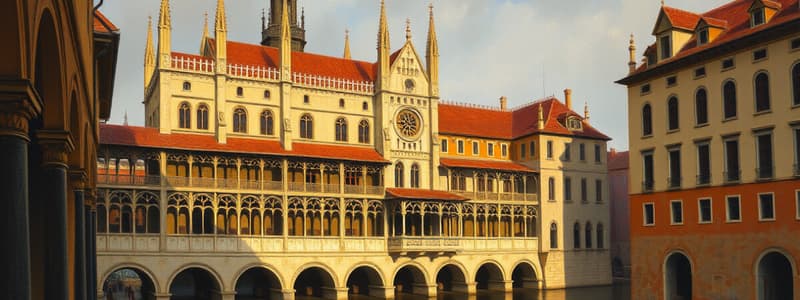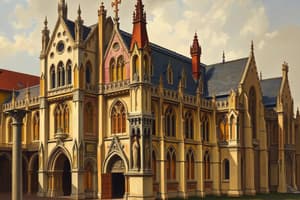Podcast
Questions and Answers
Which architectural feature is characteristic of Early Christian Churches?
Which architectural feature is characteristic of Early Christian Churches?
- Atrium with fountain of ablution (correct)
- Stone vaulting
- Flying buttresses
- Pointed arches
What distinguishes a Stone Keep from other medieval structures?
What distinguishes a Stone Keep from other medieval structures?
- Only used in rural settlements
- Built primarily of timber
- Constructed of stone for greater defense (correct)
- Utilizes a motte
Which of the following is not a part of a typical Early Christian Church?
Which of the following is not a part of a typical Early Christian Church?
- Ambo
- Bema
- Choir
- Refectory (correct)
Which structure was characterized by having a transition space from the atrium to the nave?
Which structure was characterized by having a transition space from the atrium to the nave?
Which of the following elements is associated with both Early Christian and Byzantine architecture?
Which of the following elements is associated with both Early Christian and Byzantine architecture?
In medieval architecture, what is a Motte and Bailey?
In medieval architecture, what is a Motte and Bailey?
What type of architectural style is primarily noted for simplicity and coarseness in execution?
What type of architectural style is primarily noted for simplicity and coarseness in execution?
Which part of a monastery is specifically used as a space for reading and writing?
Which part of a monastery is specifically used as a space for reading and writing?
Which element is primarily associated with Byzantine architecture?
Which element is primarily associated with Byzantine architecture?
What is a defining feature of Gothic architecture?
What is a defining feature of Gothic architecture?
What material is predominantly used in Romanesque architecture?
What material is predominantly used in Romanesque architecture?
Which structure is known as an example of Islamic architecture?
Which structure is known as an example of Islamic architecture?
Which feature is NOT typically found in Renaissance architecture?
Which feature is NOT typically found in Renaissance architecture?
What is a major characteristic of Islamic mosques?
What is a major characteristic of Islamic mosques?
Which of the following structures is an iconic symbol of Romanesque architecture?
Which of the following structures is an iconic symbol of Romanesque architecture?
Which architectural style is characterized by elements like spires and tracery?
Which architectural style is characterized by elements like spires and tracery?
What distinguishes Byzantine architecture from other architectural styles?
What distinguishes Byzantine architecture from other architectural styles?
Which of the following is a key feature of Romanesque architecture?
Which of the following is a key feature of Romanesque architecture?
Which of the following structures features a Mughal architectural style?
Which of the following structures features a Mughal architectural style?
What architectural style is known for its revival of classical arts?
What architectural style is known for its revival of classical arts?
Which type of arch is commonly associated with Islamic architecture?
Which type of arch is commonly associated with Islamic architecture?
Flashcards are hidden until you start studying
Study Notes
Medieval Architecture
- Chief structures include houses, motte and bailey, stone keep, castles, and forts.
- Noteworthy house type: Cruck-framed house, characterized by curved timber frames.
- Motte and Bailey design features a raised earthwork (motte) and a wooden or stone structure (bailey).
- Stone keep castles served as fortified structures with thick walls for defense.
- Forts were built for military protection, with various designs depending on the needs of the time.
Early Christian Architecture
- Major structures include churches and monasteries, featuring simpler designs inspired by Roman basilicas.
- Church layout includes an atrium, narthex, nave, and side aisles.
- Key parts of a church:
- Atrium: Forecourt for ablution.
- Narthex: Transition area.
- Nave: Central aisle, usually wider.
- Choir: Partially enclosed area for clergy.
- Ambo: Pulpit for reading scriptures.
- Confessio: High altar where saints are buried.
- Monasteries typically located in remote areas and include cloisters, scriptoriums, and refectories.
- Emphasis on simplicity and coarseness of execution, often using remnants of Roman buildings.
- Example: Old St. Peter’s Basilica, showcasing early Christian architectural elements.
Byzantine Architecture
- Characterized by grand exteriors and rich, decorative interiors.
- First to utilize domes and pendentives effectively.
- Notable for the use of mosaics, frescoes, and Roman-style mouldings.
- Seminal structures:
- Hagia Sophia in Istanbul, known for its massive dome.
- Sultan Ahmed Mosque (Blue Mosque) in Istanbul, famed for its architecture and intricate tile work.
- St. Basil’s Cathedral in Moscow, recognized for its unique design and colorful onion domes.
Islamic Architecture
- Famed for intricate decorations, calligraphy, and foliage motifs.
- Introduced structures such as mosques with various types including Friday mosques (Jami), collegiate mosques (Madrasah), and tomb mosques.
- Key mosque components:
- Fawwara: Fountain for ablution.
- Mihrab: Niche indicating the direction of Mecca.
- Mimbar: Pulpit for sermons.
- Important structures:
- Al-Haram Mosque in Mecca, a focal point for Muslim pilgrimages.
- Dome of the Rock in Jerusalem, significant for its religious association with Muhammad's ascension.
- Taj Mahal in Agra, a Mughal architectural marvel built from white marble.
- Court of the Lions at Alhambra, an example of Moorish architecture.
Romanesque Architecture
- Noted for its sober and dignified style using stone and brick primarily.
- Architectural features include arcuated construction, rib and panel method, and the use of decorative elements derived from nature.
- Commonly includes arcaded façades, wheel windows, and blind arches.
- Structures often follow a defined portal design, featuring tympanum and trumeau.
- Notable example: Pisa Complex, recognized as a significant icon of Romanesque architecture, including the cathedral and the iconic leaning tower (Campanile).
Gothic Architecture
- Recognized for its lofty and aspiring designs utilizing stones and timber.
- Architectural innovations include lancet arches, flying buttresses, and vaulted ceilings.
- Decorated with stained glass windows and rose windows, creating a vibrant interior.
- Notable structures:
- Notre Dame de Paris, famous for its gargoyles and rose windows.
- Rheims Cathedral, notable for its stunning facade and historical significance.
- Cologne Cathedral, recognized as one of the largest cathedrals in Europe.
- Salisbury Cathedral, featuring the tallest spire in England.
- Winchester Cathedral, the longest Gothic cathedral in Europe (170 m).
- Milan Cathedral, the third largest church in Europe.
Renaissance Architecture
- A time of dignity and formality with a revival of classical norms and human proportions.
- Utilized columns, beams, and arches in construction for harmony and balance.
- Noted for frescoes, carvings, and elaborate scrollwork as decorative elements.
- Emphasis on standardization of classical orders with guidelines established by architects like Giacomo Barozzi da Vignola.
- Important architectural advancements included the use of domes, rusticated masonry, and principles of symmetry and proportion.
- Significant structures include churches and palaces emphasizing classical designs, reflecting the era's values and aesthetics.
Studying That Suits You
Use AI to generate personalized quizzes and flashcards to suit your learning preferences.




